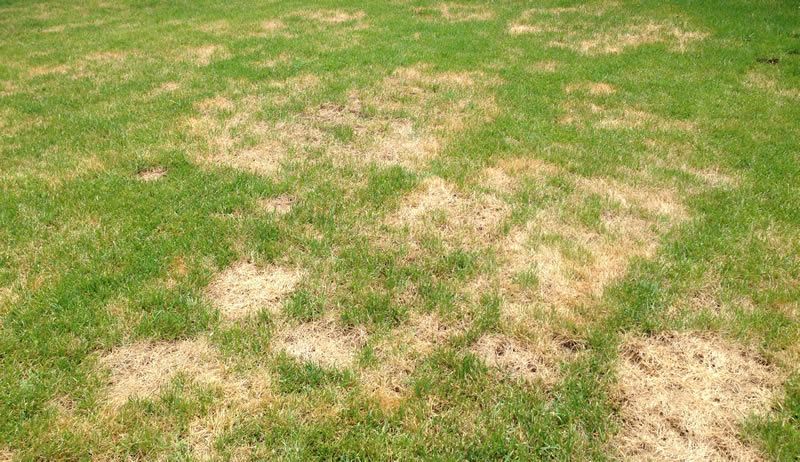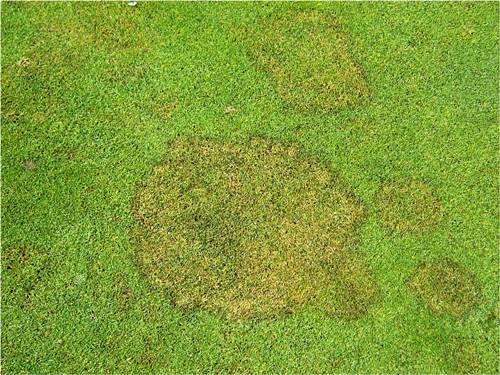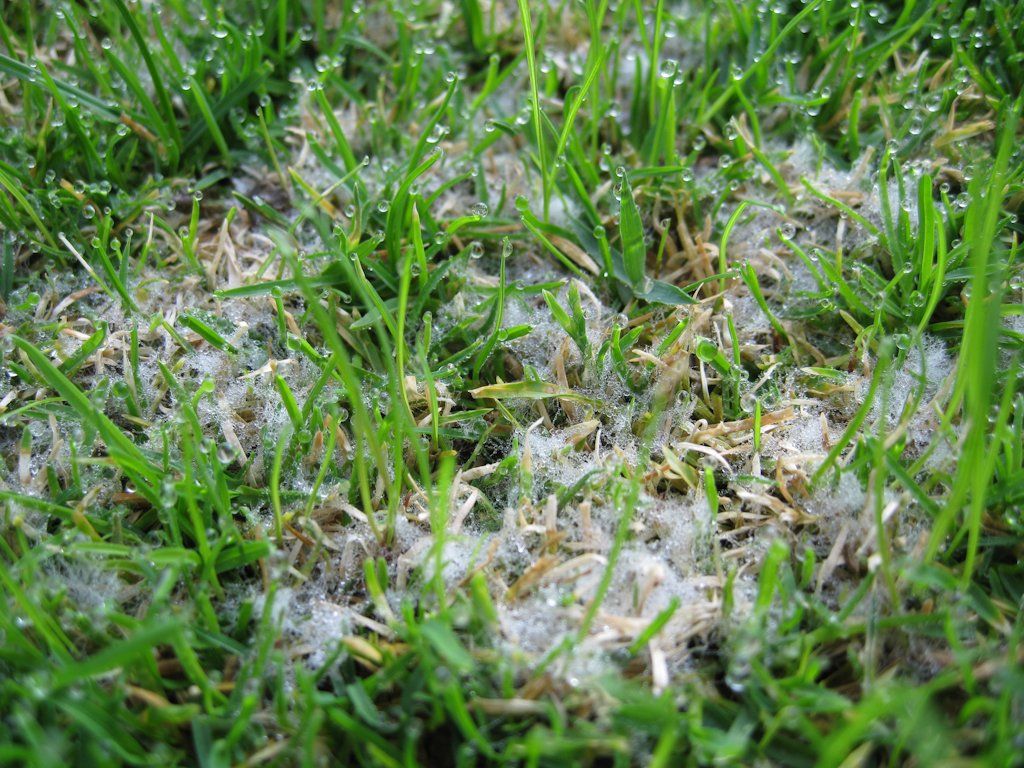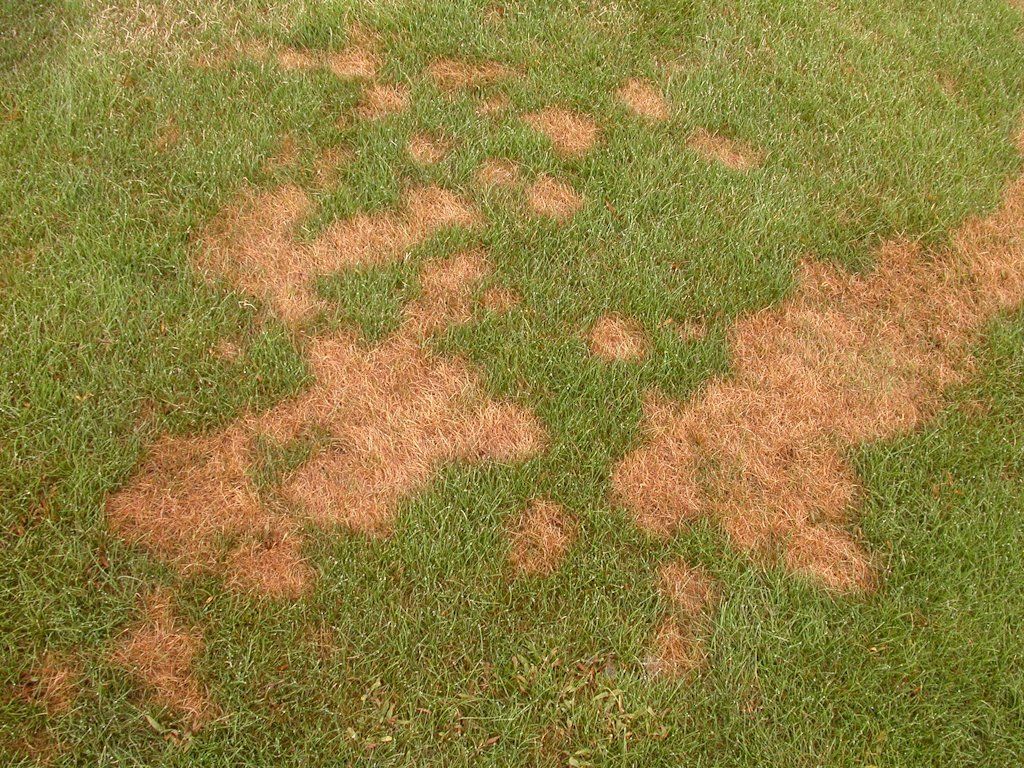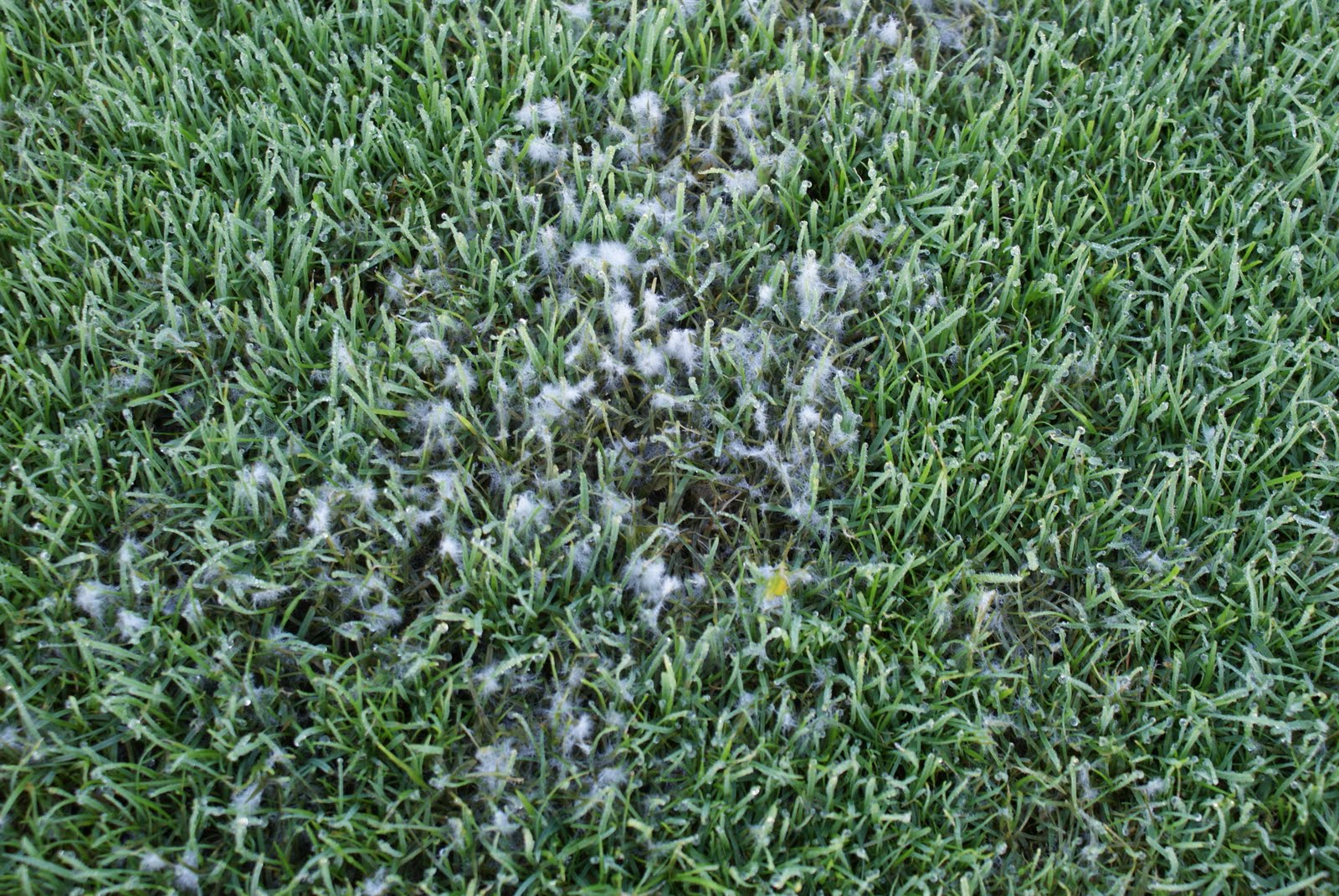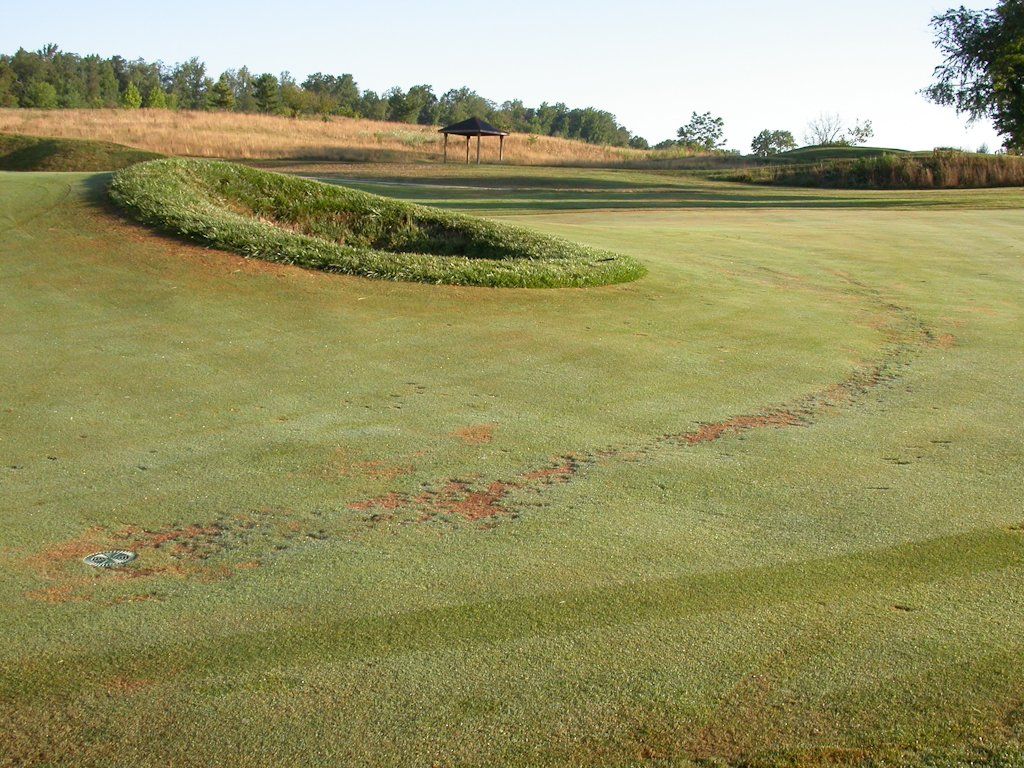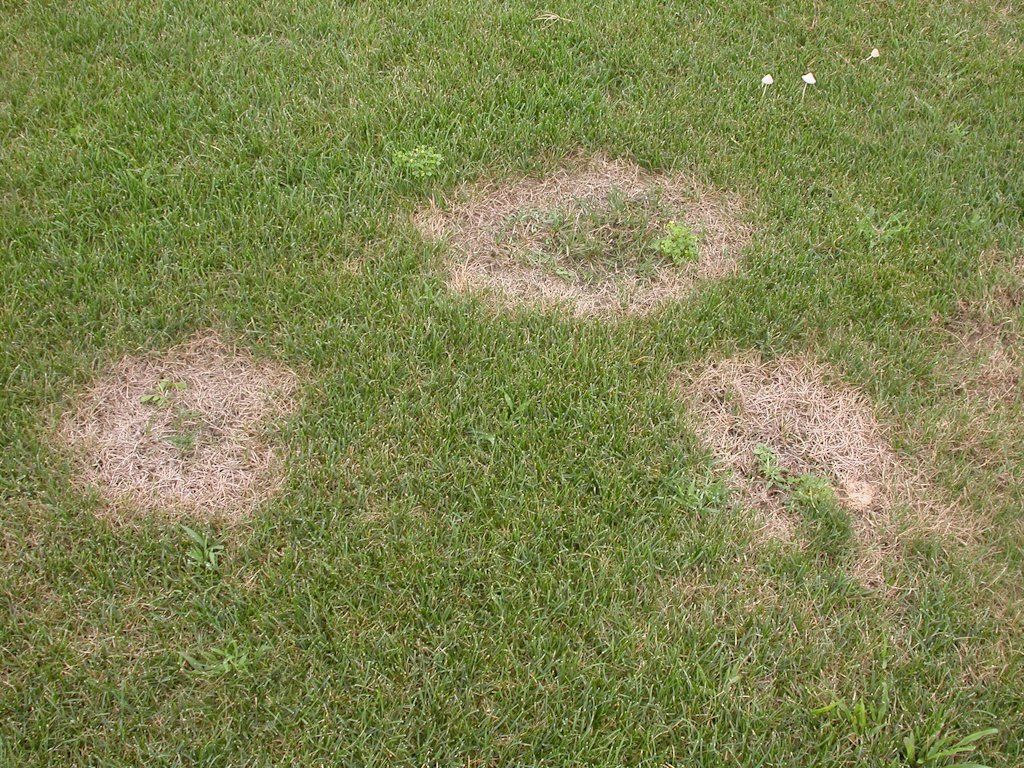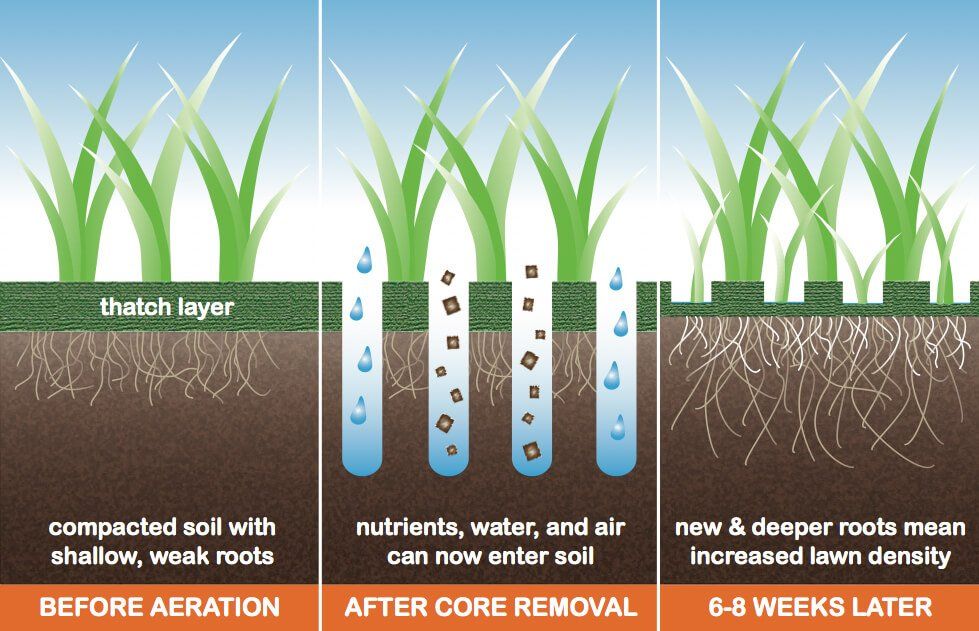Each season comes with its own set of stresses and challenges for turf grass. While it’s true that in general, more heat and moisture will increase the growth rate of common turf grasses, too much of either of these elements can add significant stress to turf. Extreme conditions sometimes foster an environment that encourages turf pathogens to take hold. Now that summer is in full swing, let’s look at three common summer turf diseases Brown Patch, Pythium Blight and Summer Patch. Spotting these diseases in the early stages will help you mitigate damage from these diseases before it becomes all encompassing.
BROWN PATCH
What to look for
Also known as “Rhizoctonia blight,” brown patch is caused by Rhizoctonia fungi. Brown patch becomes problematic during periods of high heat and humidity. It is most pervasive when low temperatures bottom out near 70F and day temperatures routinely exceed 85F. While warm season grasses are not immune, Brown Patch typically affects cool season grasses more severely.
Rhizoctonia fungi pathogens begin by infecting the leaf blade. A brownish-purple band borders the lesions in the infected blade region. Sometimes turf can withstand blade infections, but should the fungus work its way into the crown (the actively growing region of the turf at ground level), most turf cannot survive. Brown patch starts as a small circle, then quickly expands in all directions, often leaving an affected patch more than 3 ft in diameter. A ‘smoke-ring’ with a blue or white appearance can often be seen on the leading edge of the patch as the fungal pathogen expands into healthy turf. ‘Cobweb-like’ structures can sometimes be seen when sunlight hits early morning dew in affected patches. These structures are the mycelium of the fungus; they are essentially filament-like extensions that help the fungus spread into new territory.
What to do
The rate of brown patch infection is completely dependent on various environmental factors. Unfortunately, a large patch can develop from perfectly healthy turf in under 24 hours, making this one of the more aggressive turf pathogens. Fungicides may be applied, however once the problem is spotted, most of the damage has probably already been done. In the event of an infection, curtail the use of nitrogen fertilizers. If possible, ensure the affected soil has adequate drainage. Once the patch has stopped expanding, begin the remediation process by sparingly using slow-release fertilizer (less than .25lbs/1000sqft). To accelerate recovery, adjust your mower height to a slightly higher setting and allow the turf to fill back in.
PYTHIUM BLIGHT
What to look for
Also known as “grease spot” or “cottony blight,” Pythium blight can be problematic for a variety of ryegrasses and bentgrasses. Pythium blight is typically identified as a smattering of irregularly shaped spots ranging from .5 to 4 inches in diameter. Affected areas turn brown quickly. Similar to that of Brown patch, the mycelium of the Pythium fungus can sometimes be seen on dew-soaked turf in the early morning. Pythium is an extremely hardy fungus, often overwintering in spore form inside grass clipping and other biodegrading plant material in the thatch layer. When temperatures exceed 85F, Pythium is particularly destructive.
What to do
Once identified, first cease the use of all fertilizers. The application of a fungicide is highly recommended the moment this fungus becomes problematic. On turf that has a history of Pythium blight, preventative fungicide applications are recommended. Ensure that the turf has adequate drainage. Once the disease appears to have halted its expansion, begin applying low doses of slow release fertilizer. Do not water lawns in the evening or at night. To prevent Pythium outbreaks in subsequent years, consider proper dethatching and aeration techniques in early fall and early spring (before rapid turf growth).
SUMMER PATCH
What to look for
Caused by the fungal pathogen Magnaporthe poae, summer patch (sometimes called ‘Poa patch’) primarily affects Kentucky bluegrass and other smaller fescues. It is particularly aggressive in high-maintenance lawns such as fairways. Summer patch is most commonly observed in areas of high foot traffic, poor drainage, and thatch build-up. The fungal pathogen begins by infecting root systems early in the spring, long before symptoms become visible. Eventually, stressed root systems under high soil temperatures (65F+) succumb to rapid pathogen expansion across the plant. Small circular patches appear in clusters overnight. Within a day or two, patches can expand to more than 12 inches in diameter.
What to do
In the event of a summer patch outbreak, penetrant fungicides are recommended because they are better able to move into the root zone (the primary area of infection), however they are rather expensive, and only recommended in the event of a severe outbreak. The fungicide will be most effective when the pathogen is most active, therefore it is recommended that soil temperatures achieve a maximum of 65F+ for 3 consecutive days before application.
There are many preventive measures that may be employed to reduce the chances of an outbreak. Core aeration/deep tine aeration in the fall and spring assist turf rooting by breaking up the thatch layer and increasing air exchange with the soil. Prolonged, but infrequent irrigation helps to prevent the kind of environmental conditions that encourage the Magnaporthe poae pathogen from establishing. Ensure that turf has an adequate supply nitrogen to reduce plant stress (always follow the recommended application rate of any fertilizer based on the climate and grass species). In the hot summer months, it is recommended that bluegrass and other smaller fescues receive no more than 0.1-0.2 lbs N per 1000sqft. Cutting the turf height to 2.5-3 inches will also reduce turf stress, making it less susceptible to fungal pathogens. Once the pathogen has run its course, new bluegrass blades may begin to fill in from the center outward, however in the more severe cases, topdressing and reseeding may be necessary.
FINAL THOUGHTS
Turf diseases caused by fungal pathogens are very difficult to prevent outright because they spread very quickly. Good lawn maintenance practices in conjunction with knowing what symptoms to look for can mean the difference between having to remediate a few small affected patches of turf OR having a full-blown fungal outbreak across your yard. Keep your lawn green and health this summer; when the weather turns hot and humid, stay vigilant!
For professional fertilizers, humic and AMP-XC™ enriched products available, please visit TurfCare’s online Product Catalog.
For green industry professionals or others interested in ordering Turfcare products, please contact our Customer Service
to find a distributor near you.
Resources:
https://plantscience.psu.edu/research/centers/turf/extension/factsheets/managing-diseases/pythium
https://siteone.com/home/resources-services/technical-support/pythium-blight.aspx
https://www.lawn-care-academy.com/lawn-diseases.html
https://www.trugreen.com/blog/lawn-disease/what-is-brown-patch-lawn-disease
https://plantscience.psu.edu/research/centers/turf/extension/factsheets/managing-diseases/summer-patch
http://ipm.ucanr.edu/PMG/r785100611.html
http://www.msuturfdiseases.net/details/_/summer_patch_18/
Pictures:
http://www.centralsodil.com/media/wysiwyg/brown_patch.jpg (Brown patch 01)
http://www.msuturfdiseases.net/images/galleries/brown-patch/1.jpg(Brown patch 02)
https://i.pinimg.com/736x/e2/b1/bf/e2b1bfd012f17da4017155f47f79e0dc.jpg(Brown patch 03)
http://www.turfdiseases.org/turfdisewp/wp-content/uploads/2011/07/Dollar-spot-81.jpg(Brown patch 04)
http://www.turfdiseases.org/turfdisewp/wp-content/uploads/2011/07/Pythium-blight-51.jpg (Pythium blight 01)
http://2.bp.blogspot.com/_sy6qQG9pOaw/TFrqTk6DLwI/AAAAAAAAA8M/HNgfEKz-eGA/s1600/Pythium+2.JPG(Pythium blight 02)
http://www.turfdiseases.org/turfdisewp/wp-content/uploads/2011/07/Pythium-blight-21.jpg(Pythium blight 03)
https://upload.wikimedia.org/wikipedia/commons/thumb/f/f8/Pythium_%28257_23%29.jpg/1200px-Pythium_%28257_23%29.jpg(Pythium blight – fungi – 04)
http://www.turfdiseases.org/turfdisewp/wp-content/uploads/2011/07/summer-patch-31.jpg
http://simplygreenlawncare.com/wp-content/uploads/2013/03/core.jpg
http://www.turfdiseases.org/turfdisewp/wp-content/uploads/2011/07/summer-patch-21.jpg
Turf Care Supply - TurfReport Blog
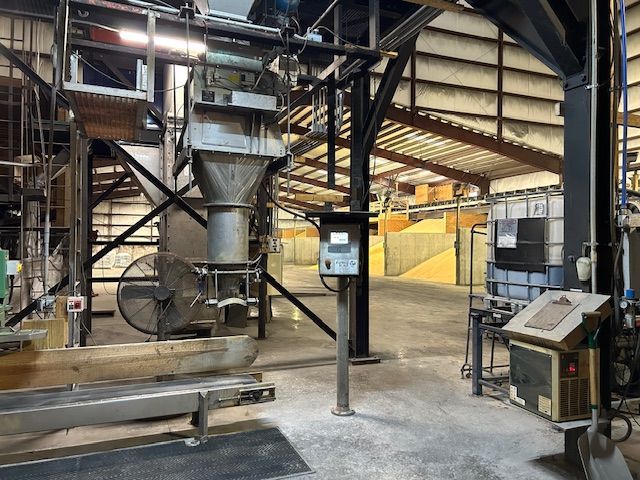
Turf Care Supply, LLC, a portfolio company of Platte River Equity, has officially acquired Beaty Fertilizer, the industry respected Tennessee-based manufacturer and blender of custom granular and liquid fertilizers, as well as combination products. This strategic move expands Turf Care’s manufacturing footprint, adds new product capabilities, and enhances overall production capacity. “The partnership with Beaty Fertilizer marks a major milestone in our journey and an important step forward in our mission to grow, innovate and lead in our industry,” said Mark Mangan, President of Turf Care. “This acquisition is more than just expansion; it’s a powerful opportunity to strengthen our product offerings, broaden our market reach and provide greater value to our customers. By welcoming Beaty into the Turf Care family, we are reinforcing our commitment to excellence and positioning ourselves for an even brighter future.” “We are excited about this next step in the Beaty Fertilizer story. For almost 50 years, our family and our employees have worked hard to serve customers and communities with pride and heart,” said John Beaty, President of Beaty. “Now, we are embracing an opportunity for growth with Turf Care. With our combined know-how and resources, we’ll keep building on what we’ve worked so hard to create and bring even more value to our customers, employees and partners. We truly believe this partnership will keep the Beaty legacy going strong while opening up new doors for growth and innovation.” Tarun Kanthety, Vice President at Platte River, added, “We believe the acquisition of Beaty Fertilizer represents a strategic step in expanding Turf Care’s footprint and product breadth... as it scales and enhances its value proposition to customers.”
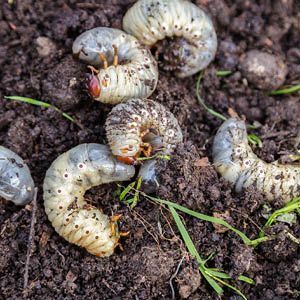
Root out Grubs, Before they Attack Yours! White grubs, the immature stage of several scarab beetles—including Japanese beetles, masked chafers, May and June beetles, and green June beetles—are a major threat to turfgrass across the Southeast. These beetles follow a complete metamorphosis (egg, grub, pupa, adult), with most species completing their cycle in one year. Eggs are laid in early summer, grubs hatch within two weeks, and begin feeding on turfgrass roots through the late summer and fall. May and June beetles differ slightly, with a two- to three-year life cycle and prolonged feeding as third-instar grubs. Grubs damage turf by severing roots, causing grass to yellow, wilt, or lift easily from the soil. Feeding is typically concentrated in patches and worsens during hot, dry weather. Wildlife digging for grubs can create further turf destruction. Healthy turf may tolerate 5–10 grubs per square foot, but damage becomes evident as populations rise or turf is under stress. Early detection and timing are essential. Scouting begins in late June, shortly after adult beetle activity peaks. Monitoring plants favored by beetles can signal egg-laying is underway. Treatment is most effective when small grubs are active—typically from mid-July through early August. For professional turfgrass managers, insecticides containing imidacloprid (Merit®), chlorantraniliprole (Acelepryn®), or trichlorfon (Dylox®) are the most effective tools. The primary months of preventative application of Acelepryn® is from April to end of May and Merit® from April into July - targeting grubs before they hatch. Curative treatments with Dylox® or similar products are applied July through the fall, when young grubs are feeding and most vulnerable. Always follow label directions for optimal application and safety. Timing may vary slightly by regional seasonal needs. Turf Care Supply has a variety of professional TCS Growstar insecticide fertilizers available to protect your turf and prevent grub damage, before it starts. Click on the button below to view products, contact your sales rep for addition TC Growstar products available.
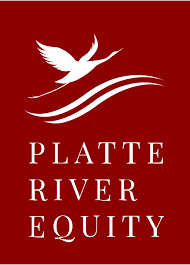
Platte River Equity Portfolio Company Turf Care Supply, LLC Acquires Agri-Nutrients, Inc. Brunswick, OH , October 9, 2024 – Platte River Equity (“Platte River”) portfolio company Turf Care Supply, LLC (“Turf Care”) is pleased to announce its acquisition of Agri-Nutrients, Inc. (“Agri-Nutrients”), a manufacturer and blender of custom granular fertilizers for the turf & ornamental (“T&O”) industry. This strategic acquisition provides Turf Care with an established presence in the south-central United States, an enhanced product portfolio and additional manufacturing capacity. “This acquisition represents much more than a business transaction; it is a strategic step forward in expanding our reach and enhancing our customers’ growth. By bringing Agri-Nutrients into the Turf Care family, we are broadening our product portfolio, expanding our market presence and further positioning ourselves as a leader in providing innovative solutions for our customers,” said Mark Mangan, President of Turf Care. “We are excited about joining the Turf Care team,” said Jim Montgomery, President of Agri-Nutrients. “At Agri-Nutrients, our core values center around customer service and product innovation, and we are confident that this combination will allow us to better serve the needs of our customers.” “Platte River welcomes the Agri-Nutrients team to Turf Care. This transaction underscores our long-term commitment to fostering growth through both organic and inorganic initiatives across the Turf Care platform,” said Tarun Kanthety, Vice President of Platte River. “The partnership with Agri-Nutrients strengthens Turf Care’s value-added offering, creating additional growth opportunities across the combined customer base.” B&A Corporate Advisors served as the exclusive financial advisor to Agri-Nutrients. About Agri-Nutrients Founded in 1992 and based in Catoosa, OK, Agri-Nutrients is a manufacturer and blender of custom granular fertilizers for the T&O industry, predominantly selling into the lawn care, sports turf and golf course end markets. About Turf Care Supply Established in 1974, Turf Care Supply is one of the largest formulators and blenders of urea products to the T&O market. Turf Care has a comprehensive product portfolio of fertilizers, combination products (herbicide/insecticide), soil amendments and enhanced efficiency fertilizer ingredients. Turf Care's products are sold to distributors and blenders serving the commercial, residential and golf end markets. Turf Care operates four manufacturing facilities strategically located throughout the eastern U.S. About Platte River Equity Founded in 2006 and based in Denver, CO, Platte River Equity is a private equity firm focused on investments in established lower middle market operating companies within targeted industrial sectors where it has substantial operating and investing experience. Platte River utilizes prudent capital structures in order to invest in future growth opportunities and withstand changing economic environments. The firm also provides significant ongoing support to its portfolio companies through dedicated resources across functional areas. The firm has raised funds with committed capital in excess of $1.6 billion and is currently investing out of its fifth fund. The Platte River team is the largest collective investor across its funds, deeply aligning the firm with its investors and portfolio company management teams.


